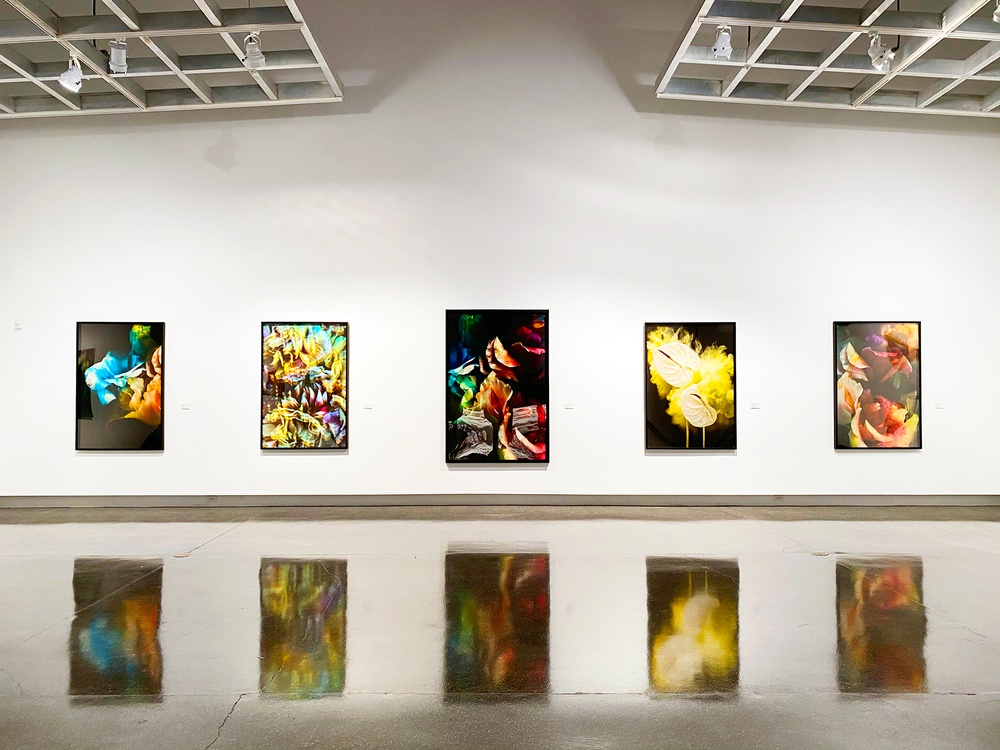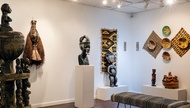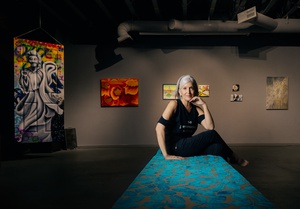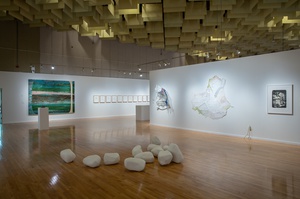Let’s begin with what’s going right.
If you want to see visual art created by locals, there are places to do that. There are several galleries throughout the Valley showing work by local artists. Downtown Las Vegas’ 18b Arts District hosts a concentration of galleries, and its monthly First Friday community fair brings art into the streets. City, county and state galleries show a constant stream of Nevada artists. Many of the exterior walls of the Arts District and the nearby Fremont East district are covered with murals by artists both local and international, a trend that’s slowly making its way onto the Strip and into the suburbs.
If you’d like to see art by national and international artists, there are places to do that, too. UNLV’s Marjorie Barrick Museum of Art, located on campus, regularly programs eye-popping, educational shows into its multiple galleries. The same is true of multiple branches of the Las Vegas-Clark County Library District, particularly the super-sized galleries of the Sahara West Library. And there are works by “blue chip” artists deposited throughout our casinos—Damien Hirst pieces at the Palms, James Turrell installations at the Shops at Crystals, an ever-changing selection at the Bellagio Gallery of Fine Art and so on.
If you want a better understanding of art history and technique, UNLV and the College of Southern Nevada will teach you. If you want to create art, there are venues that can lease you a studio space; supply shops to stock it; and state, city and educational grants you can apply for to fund the whole thing. And if you want to put art in your home, visit any of those galleries alluded to earlier; they’d absolutely love to see you.
Yet the headwinds Vegas’ art scene faces are real and relentless. The walls of those private, civic and library galleries are programmed for months out, forcing artists to compete for eyeballs. It’s a struggle for creators to maintain both living and creative spaces, even with grant money. Artists are forced to limit their creativity to the hours they’re not working, raising families or attending school. Most significantly, Las Vegans don’t acquire local art in the volume that would allow artists to work without stress, much less call this city an “art market” without using air quotes.
It feels like the pieces we need are there, but they’re not fitting together. They’re either the wrong shape, or they’re just too small.
Spoiler alert: These problems won’t be fixed over the next few hundred words. I’m not much of a visual artist, but I do know lots of great local artists and gallerists, and I recently met with four of them—Nancy Good, Brent Holmes, Bobbie Ann Howell and Krystal Ramirez—to consider the challenges that Vegas’ artists face. (Their comments have been edited for length and clarity.)
The Walls
“We need more curated exhibition spaces,” says artist and gallerist Nancy Good, whose art space Core Contemporary is one of the prime draws of the nascent cultural district forming within the resurgent Commercial Center retail village. “I send my [out-of-town] visitors to the libraries, to Priscilla Fowler Fine Art, to Left of Center Gallery, to Recycled Propaganda, to the Arts Factory, to whatever studio that I think might be open at that time. But we need more walls.”
Brent Holmes, a multidisciplinary artist, curator and writer whose work recently won him a Nevada Arts Council fellowship—and whose appraisal of Vegas’ art scene is
almost brutally frank—says the city could use more curated art spaces, but of a specific kind. He also thinks they might be doomed before they open.
“We have a very narrow number of selling exhibition spaces,” Holmes says. “Selling gallery spaces are few and far between. Most of them are in one neighborhood, which is absurd. And most of them don’t do that well financially. The majority of them are individual or vanity galleries run by people that make enough money in other avenues to support themselves and can just so happen to afford to rent the space.
“We don’t have a real art-buying class [in Vegas],” he continues. “Outside of First Fridays, almost no [gallery] in the Arts District cuts a profit all month long. They all have to wait around for that one day of the month to make their rent.”
At this point, you might be asking, so what? Many of us think of the arts as a side dish, an elective—something no sane person would double down on while there’s law degrees to be pursued or bitcoin to be mined. But the arts are as strong a profit driver as any of the professions we’ve been conditioned to think of as “real jobs,” says another Nevada Arts Council 2023 fellow, and the Nevada Humanities gallery’s “program wrangler,” Bobbie Ann Howell.
“The world knows [the United States] by our culture and arts—film, literature, music,” she says. “It’s a huge industry.”
Howell suggests that government incentives, such as live/work zoning ordinances, aren’t such a crazy idea. They could keep those Arts District galleries afloat, and perhaps even encourage a few more to open. And civic help for the visual arts, with an eye toward building something bigger and more robust around them, isn’t without precedent.
“A few years back, Paducah, Kentucky, was just trying to get people to move there. If you were in a creative industry, especially ceramics—because they had a ceramics factory there—they helped you with a down payment on their old houses. They were incentivizing people to move there for cultural purposes, because that’s what they wanted to develop,” Howell says. “And a couple years ago, Tucson [Arizona] did a downtown revitalization, really upping its cultural game to become a hub not just for the community, but for tourists.”
To see this idea in local practice, consider the advent of First Friday in Las Vegas and the creation, some years later, of the Arts District. In October 2002, when Cindy Funkhouser, Naomi Arin and Julie Brewer made an agreement with Arts Factory owner Wes Isbutt to coordinate the neighborhood’s gallery openings on the First Friday of each month, the neighborhood surrounding the Arts Factory was comprised of antique shops, light industry and empty storefronts. Today, it’s home to quirky bars, upscale restaurants, a proliferating number of breweries and a boutique hotel.
Consider, also, the nearly cavalier attitude that Strip properties have taken in making blue chip art part of their thing. Valet parking used to be a low-frills affair; today, at Aria, you can side-eye a Jenny Holzer installation while you wait for your car to be brought up. It’s thrilling, says Good, but it also comes back to the issue of local artists on local walls.
“The hotel properties, the convention and visitor center properties … those are great walls. Why not showcase the local talent that we have here, if you’re about the Vegas experience? We are the true Vegas experience,” Good says. “All this blue-chip art is really becoming redundant. [The Strip properties] show you the influence of Basquiat, the influence of Dalí, the influence of Koons. They all matter and have their place, but if people are coming to Vegas for the Vegas experience, let us give you art that’s not derivative of all this other art that everybody has seen over and over and over again.”
The point is that art, as a vibe, sells. And it blows Holmes’ mind that Las Vegas hasn’t gone even bigger on it, like Miami has with its American version of Switzerland’s Art Basel.
“We are one of the convention hubs of the world. We’re certainly as fun as Miami. We got Miami beat on several angles, and still, we don’t have an art fair,” Holmes says. “Basel happens in Miami every year; it’s a major draw for multiple industries. And we still don’t have our sh*t together.”
The Knowing
If you’ve had breakfast at chef Natalie Young’s Downtown “breakfast and lunch spot” Eat, you’ve seen the work of Vegas-raised interdisciplinary artist Krystal Ramirez. One of her favorite mediums is found text, and the south wall of Eat is just that: the phrase “I’ll see you in the flowers” written over and over.
At first, it reads as whimsy, like Bart Simpson done screwed up. But the phrase is a meditation on our mortality—as in, yeah, it’s the flowers on our graves. It’s an affecting work when you want it to be, and it’s easy on the eyes when you want it to be.
But the piece also represents something else: the extraordinary opportunities that artists can sometimes enjoy here when the stars align. Back in 2011, Ramirez was working at now-defunct Fremont East coffeehouse the Beat and had some of her early work displayed on the walls. Young, who stopped by every morning for a mocha, saw a small version of the “flowers” piece and asked Ramirez to re-create it at Eat.
“She’s like, ‘I want you to make this as a mural.’ And I thought, ‘This is my big break!’ I’d never been asked to do anything like that,” Ramirez says.
Ultimately, the Eat piece ended up standing alone in Ramirez’s body of work. Someone reached out to her with a request for a similar work, but it didn’t pan out. But one of the key elements of Ramirez’s story is that Young asked her what she’d like to be paid for her piece, and Ramirez suggested $500, which at the time seemed like a lot of money to her.
“You can put that in the piece or not,” Ramirez says. “But I think it’s important to talk about money with art students and with burgeoning artists.”
That’s why it’s fortunate that Ramirez, who recently earned her MFA in Art Practice from Stanford, and others like her hang around in Vegas to share what they’ve picked up. Theory is one thing, but knowing what to charge a client is another thing entirely, as is knowing how to chase down grant money that can pay for rent and supplies, or how to apply for an art scholarship at one of the world’s most respected universities. (She got in on her third try.)
Ramirez’s return to Vegas illuminates another problem that affects all of Vegas’ cultural scenes, from music to performance: attrition. When artists leave Vegas, the scene loses institutional knowledge, loses cohesion. And for Holmes, that bond that held Vegas’ artists together a decade ago is almost completely gone.
“We don’t have the same kind of community we used to. The younger artists are more obsessed with the internet than they are with actually being around each other. The older artists are burnt out and exhausted and have no place to go,” Holmes says. “[Ten years ago], it was organic. It was alive. Everybody had dinner together. We went out for beers, and we stayed up all night. We went dancing. We made paintings. We helped each other to build shows, and we built lives together.
“We loved each other. It was enlightening, and it was beautiful. And who cared if you weren’t making enough money or you were never going to be famous, or nobody gave a f*ck about your art? I was willing to tolerate all that sh*t, living in absolute obscurity in Las Vegas for the rest of my life, for as long as all those great people and great experiences were happening.”
Ramirez thinks the spark still exists. She intends to reinvest herself in Vegas, both by being a working participant in the arts community and by sharing what she has learned with up-and-comers. And she has developed an interest in pursuing public art projects, which is great news for Vegas. Our Valley’s public art game is strong, and it’s thrilling to have her back on the home team.
“One of my professors does public art projects almost exclusively,” Ramirez says. “She showed us what the process is, and an artist that focuses on public art projects—that is an entire career.
“Artists know the opportunities that are available, but they never think that their work can translate to public art,” she continues. “Everybody’s work can translate to public art: painter, sculptor, musician, writer. Everybody, anybody in the arts. You need somebody to guide you and to figure out how it can translate.”
The Money
If there’s a takeaway from this conversation—or a conversation about nearly any of the arts, pretty much anywhere in the world—it’s that many of the problems artists face could be readily solved with more money. That need is perhaps more acute now than it ever was, with the cost of living in Las Vegas steadily creeping upward.
“Less than five years ago, Las Vegas was the kind of city [where] you could rent a two-bedroom house or a three-bedroom apartment for about $800 a month,” Holmes says. “You could work a full-time or part-time job at a wage that might have been not the best wage, but it was more than enough to accommodate your housing needs so that you could then spend the rest of your time focusing on your art. This was an especially important reason that I liked being in Las Vegas. But at this point, even with a full-time job that pays well, it’s incredibly difficult for me to maintain a household for myself, let alone myself and my children, which makes it incredibly difficult for me to make my art.”
The only way for artists to square themselves with these lopsided circumstances is to sell more art, which, as Howell says, isn’t the easiest thing. It’s not an assembly line.
“I work for a nonprofit. I don’t make a lot of money, but you know, when I see a piece of art [that I like] I want to support the artist. … The last time I had a booth at First Friday, there was guy selling 25 cent-an-ear corn for $5. Who was making the better profit; who was smarter?” She laughs. “You think to yourself, ‘Oh, I’m making things one-at-a-time that are taking hours. What am I doing?’ But, of course, artists do it because they must.”
Core Contemporary’s Good suggests that our local industry should set an example.
“We need more patronage from the businesses that are directly benefiting from art and culture, which is every casino property, every hotel property in town,” she says. “Pretty much every business benefit from artists, you know—they’ve got logos, they’ve got merchandise, they’ve got murals. It would be a bland and sterile world without artists.”
Jumping back into the conversation, I did warn you at the beginning of this piece that we weren’t going to solve the problems associated with being a working artist in Las Vegas. But if I could leave you with one suggestion, it would be to show up. Show up to gallery openings; show up to art-centered events; show up for local artists who could buy groceries or even pay their rent by selling you the work that you’re tempted to shoot with your phone instead.
Because here’s the thing: The artists are going to keep showing up. Vegas’ artists are going to keep doing what they do, even if you’re not looking. Maybe, one of these days, you might.
“My interest right now is to be able to have a studio, to be able to make work,” Ramirez says. “I don’t know if my entire life is committed to being a full-time artist, but I would love that. I want to show my work in places. I want to do all that.”
Click HERE to subscribe for free to the Weekly Fix, the digital edition of Las Vegas Weekly! Stay up to date with the latest on Las Vegas concerts, shows, restaurants, bars and more, sent directly to your inbox!







